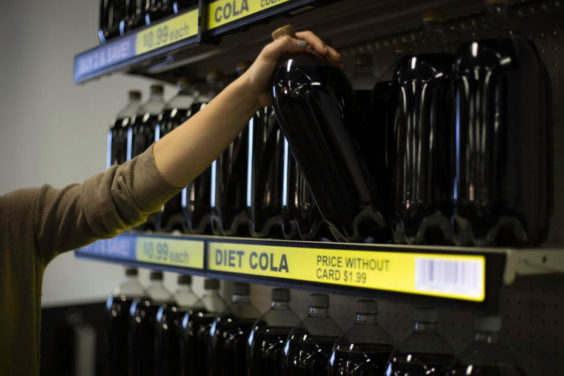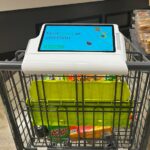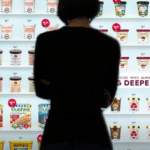
To paraphrase that noted retail marketing expert Yakov Smirnoff, in this grocery store, you don’t look at shelves full of groceries – the shelves full of groceries look at you!
Which grocery store? Well, maybe yours.
A newly-unveiled “smart shelf” will be available to grocery stores across the country later this year. The shelf edges feature digital displays that can blink, flash, animate and alert you to specials.
Sounds cool. Oh, and the shelves will also scan your face to determine your age, gender, ethnicity and your emotional reaction to the display.
Sounds… creepy?
The retail technology company Cloverleaf has officially announced “shelfPoint”, which it describes as the industry’s “first emotional artificial intelligence shelf solution”. As you watch the colorful, moving displays to get information about the featured products, the shelves are busy gathering information about you.
The idea is to help brands and retailers collect consumer data “by attracting, engaging and converting customers in one of the most underutilized yet powerful areas in the store: the shelf,” Cloverleaf CEO Gordon Davidson said in announcing shelfPoint’s launch. The company says its signage appeals to “shoppers distracted by their devices and trained to look only at what is digital.”
In other words, come, look at the shiny, moving, mesmerizing images dancing before your eyes – all the better to make you linger long enough to have your face scanned by tiny cameras embedded in the shelves.
The technology in shelfPoint “classifies shoppers’ facial expressions and overall sentiment”, assigning them certain emotional states like “joy,” “sadness,” “anger,” “fear” or “surprise.” Happy to see a new product in your store? Angry that prices have gone up? Fearful of the sorcery that’s animating what used to be simple paper shelf tags at your local store? Now your store will know about it, in real time.
Retailers and marketers will be able to analyze that information to determine whether the display, the products or the prices are pleasing to shoppers. In theory, the display could even be adjusted on the spot in response to your reaction – if you appear displeased or unsure, for example, the display could alert you to a special offer that might help close the deal and convince you to buy the product.
Cloverleaf says a recent test with Procter & Gamble and other brand partners at “a major grocer” in the Northeastern U.S. helped boost sales by nearly 40% over the traditional “stagnant cardboard cutouts and layered sticker price tags.”
shelfPoint shelves may be “smart”, but they’re not the first of their kind with the ability to analyze shoppers. Snack maker Mondelēz International has experimented with a checkout display that features different offers and promotions based on the demographics of the person looking at it. Rite Aid’s “3D Reward Centers” also feature ads and coupons tailored to shoppers’ age and gender.
But will shoppers really go for this kind of thing – especially if they’re not informed, or asked, beforehand? A recent survey found that two-thirds of shoppers said facial recognition technology that triggered product recommendations or discounts based on your identity or demographic information, was just plain creepy.
Cloverleaf insists that its technology does not capture or store any personally identifiable information – the facial scan only produces data, and only retains it for a short time. So there won’t be video clips out there somewhere, of you gazing longingly at the cookies, or loading bags of potato chips into your cart.
But then, your store has plenty of surveillance cameras already. So you’re not exactly doing your grocery shopping in private as it is. With shelfPoint, your store will be able to take it to the next level, by more actively monitoring your behavior and providing you with “a more personalized and engaging experience”.
“Cloverleaf is providing a solution for the retail industry that’s long overdue – insight at the moment of decision,” Endpoint Technologies Associates president Roger Kay said as part of Cloverleaf’s announcement. “Many companies have tried to address this critical moment with beacons, electronic shelf tags, and cameras, but these technologies have been inadequate. shelfPoint could make a real difference here with its innovative approach.”
If you’re like a lot of people, you may be trying to watch what you eat and watch what you’re spending in the new year. You just probably never anticipated that marketers would be watching your every move – and mood – while you do it.
Image source: Cloverleaf
















Totally creepy. Ick.
Happy 2017!